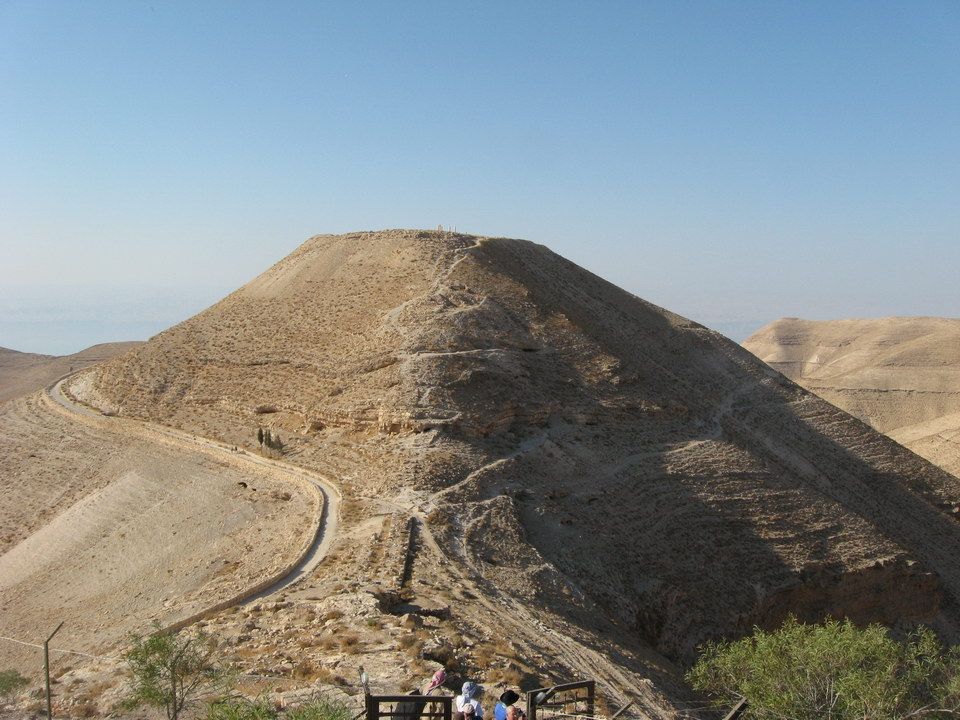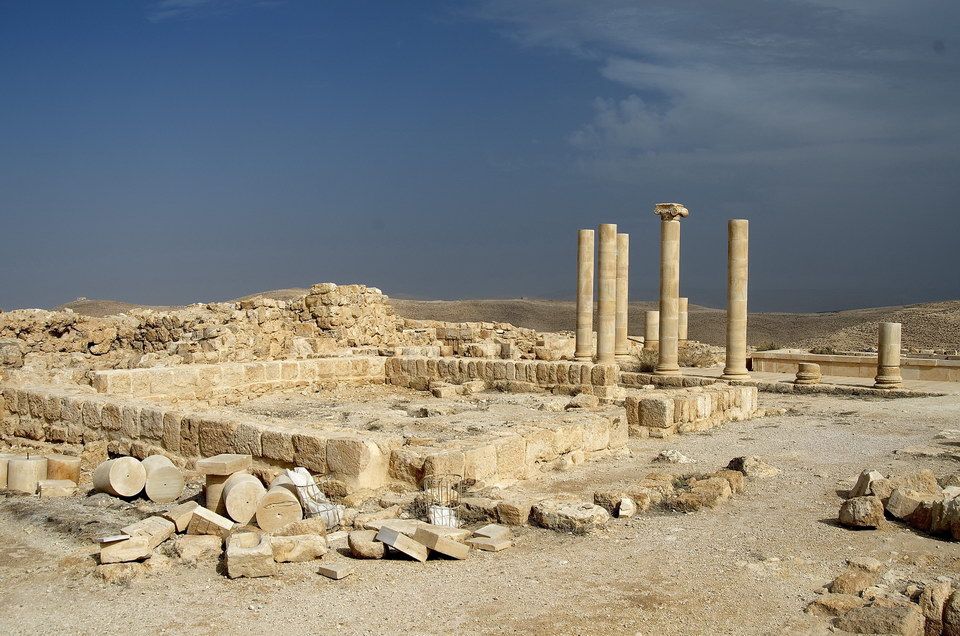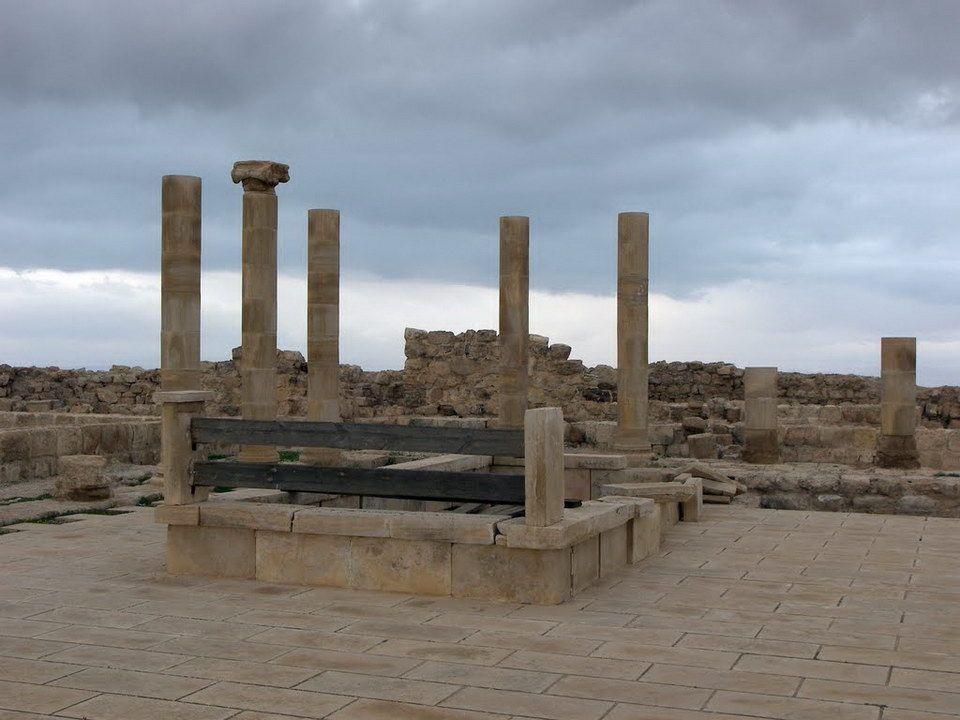The modern village of Mukawer is located 30 km to the southwest of Madaba on the south bank of Wadi Zarqa Ma in (see Appendix _The Waters of Callirhoe and Baarou/Baaras, below).
It preserves the name of the Hnsmonean-Hcrodian fortress of Machaerus built on the southern border of Jewish Peraea against the Nabataeans. It also has remains from the Roman-Byzantine period.

The archaeological site of Machaerus, found 2 km to the west of the village, is located on the east side of the Dead Sea and provides a spectacular view of it. It may be divided into two segments: the fortress ruins on the isolated spur of Qal at al-Mishnaqa , and the associated lower town built on the steep northern slope. According to Josephus (War 7), Alexander Jannaeus (reigned 103-76 BC), a Hasmonean ruler, built the fortress consisting of upper and lower segments. Gabinius, one of Pompey s generals, destroyed it in 57 BC; Herod the Great (reigned 37-4 BC) rebuilt it. After Herod s death, his son Herod Antipas inherited the fortress. Upon the latter s death in AD 39, it passed to Herod Agrippa I until his death in AD 44. After this time it came under the control of the Romans. Subsequently, during the First Jewish Revolt, Jewish rebels took control of it after AD 66. The Romans besieged the fortress in AD 72, the rebels were allowed to leave, and then the Romans tore it down, leaving only the foundations. In the 1800s, explorers visited and recorded the ruins at the site.
In 1965, the Jordanian Department of Antiquities partially excavated a church in the nearby village of Mukawer. International groups carried out further investigations at the site. The Franciscan Biblical Institute began its explorations there in 1978 and continued the work in 1979. In addition to work at the site itself, the institute excavated a second Byzantine church in the nearby village in 1989. Throughout the fortress of Machaerus, there were two main periods of occupation, followed by a short reoccupation: 1. the Hasmonean fortress (90-57 BC); 2. the Herodian fortress (30 BC-AD 72); and a short reoccupation soon after AD 72.

Palace and Fortress
The Franciscan Biblical Institute excavated the upper segment of the fortress, also called palace-fortress, on the top of Qal at al-Mishnaqa (fig. 9-4; UTM coordinates: 0749081E/3495658N; elev. 695 m) (Piccirillo 1997b). This resulted in the identification of the Hasmonean fortress, the Herodian fortress, and the fortifications of the Zealots during the First Jewish Revolt (AD 66-73)· Moreover, the institute also investigated the lower segment, the so-called lower town, on the mountain s north slope where the housing for the palace-fortress personnel was located.
The remains of the Hasmonean fortress consist of three towers on the crest of the mountain, part of the defensive wall on its southwest side, and some rooms that were reused as a substructure for the thermae - the baths - in the Herodian fortress. A tower at the northwest corner of the site s lower segment also belongs to this period. This tower was connected to a large rock-cut water reservoir of 8 m depth. The reservoir, the entrance of which was carefully masked and blocked in antiquity, is perfectly preserved. The central Herodian palace-fortress measures 110 (E-W) x 60 (N-S) meters. A north-south running corridor divided the structure into two blocks. The eastern block has a paved courtyard in the center flanked by the thermae (baths) on the south; there are also additional rooms. The western block has a peristyle of columns on the north, erected on a water cistern, and a possible trielinium (formal dining area) on the south (fig. 9.5). There are traces of mosaics within the rooms of the fortress."

Aqueduct and Bridge
An aqueduct, 15 m in height, brought rainwater from the nearby plateau to a series of hewn and plastered cisterns on the northern slope of the mountain. It also served as a bridge that connected the for-tress to the high plateau. A lower channel directed water from Wadi al-Mishnaqa into a lower series of cisterns. Only a few houses have been excavated in the lower town, which was built on the site s steep northern slope. These houses are located inside the northern retaining and defensive wall surrounding the site. The wall was defended on both sides by a tower. From inside this tower, the large cistern referred to above could be reached.
CHURCHES IN THE VILLAGE OF MUKAWER
Three Byzantine churches and/or chapels have been located in the ruins of the village of Mukawer, around 2 km to the east of the palace-fortress. The northern one, with its mosaics, was built in AD 602-603. The central church, the Church of Bishop Malechios, possibly dates from the first half of the seventh century. The third church is referred to as the West Church.
The West Church
The West Church (0749935 E/3495721 N; elev. 719 m) is located at the western extremity of the modern village, immediately south of the road leading to Machaerus. It has been investigated but not excavated. The investigations revealed that it is a basilica-style church with three aisles. Piccirillo dates a strip of mosaics in it to AD 603 (1995). Presently, it is difficult to discern any traces of the church s structure.
The Church of Bishop Malechios
The Church of Bishop Malechios (figs. 9.8-9; UTM coordinates: 0750041 E/ 3495629 N; elev. 717 m) is also located to the south of the road that cuts through the modern village. It is ca. roo m east of the West Church. It too is a basilica with three aisles, measuring 21.5 x 15 m. The bishop, after whom the church is named, was unknown until the church s discovery; he belonged to the Episcopal Seat of Madaba. A Greek inscription in the north aisle of the church mentions "Sergios and George, servants of Christ." Both are well-known from other churches in the Madaba region. Piccirillo dates the church to the end of the fifth or the beginning of the sixth century.
The North Church/Chapel
The North Church/Chapel (UTM coordinates: 0750150 E/3495658 N; elev. 706) is located on the northern slope of the hill on which the modern village is located. It is a small church or chapel, measuring 13.65 x 6 rn, with but one aisle. Its date is unknown.
APPENDIX - THE WATERS OF CALLIRHOE AND BAAROU/BAARAS
Callirhoe and Baarou/Baaras are two locations of hot/thermal springs along the northeastern shore of the Dead Sea that were of importance in antiquity. According to Josephus, King Herod the Great visited the ones at Callirhoe: "(Herod) went over the Jordan, and made use of the hot waters of Callirrhoe, which run into the lake Asphaltitis, but are themselves sweet enough to be drunk" (war 1.657). Lake Asphaltitis is, of course, the Salt Lake or Dead Sea (Alliara 1999: 56). There would probably have been a harbor on the Dead Sea at Callirhoe to land boats coming across the water from Jericho. Moreover, a pathway would have gone up the mountain from Callirhoe to Herod s palace at Machaerus (clamer 1999) Archaeological work at the site of Callirhoe shows that it was planned in connection with Herod the Great s building activities at Machaerus. Remains dating from the end of the first century BC to the end of the first century AD indicate that the area was a place of thermal baths and recreation centers close to the Dead Sea. Access would have been easy, even for sick guests arriving by boat. Villas and farm houses were located on the lower terraces of the site. After a gap of 300 years, the site was reoccupied during the Byzantine period in the second half of the fourth and the fifth century. However, occupation was sparse (Clamer 1999). Josephus also describes the place called Baarou/Baaras: "In that valley which encompasses the city (of Machaerus) on the north side, there is a certain place called Baaras, which produces a root of the same name with itself" (wars 7.180-81). The valley that Josephus refers to is Wadi Zarqa Ma in. He continues: "In this same region flow hot springs .... " According to Clamer (1998: 222), this description clearly refers to the hot springs of Hamrnarnat Ma in, situated in Wadi Zarqa Ma in, ca. 4 km inland. Josephus places Machaerus on the south side of Wadi Zarqa Ma in. Baaras is located on its north side. According to Eusebius and Jerome, in the Onomasticon and the Book on the Sites and Names of Places of the Hebrews respectively, the hot springs of Baarou/Baaras are near a very large village by the name of Beelmeon: Beelmeon (Num. 32:38). Beyond the Jordan, which the sons of Reuben built. It is a very large village near Baarou with hot waters called Beelmaous of Arabia, situated 9 milestones from Esbos. The prophet Elisha came from there (46); and Beelmeon, across the Jordan, which the children of Reuben built. It is even today a large village near Baarus in Arabia, where hot water springs spontaneously from the earth, called Beelmaus, nine miles from Esbus, whence Elisha the Prophet came (47) (Taylor et al. 2003: 32). The toponym "rneon" may be preserved in the name of the modern village of Ma in and in the water course of Wadi Zarqa Ma in. The ancient village is mainly from the Byzantine period (MacDonald 2000: Il7-I8). The given distance of nine Roman miles from Esbus (Heshbon) fits. Both Eusebius and Jerome place the home town of Elisha at Beelmeon. On the Madaba Mosaic Map the hot springs of Baarou/Baaras are placed slightly northeast of the Baths of Callirhoe, which are depicted with date palms along the east shore of the Dead Sea. This position corresponds to the hot springs of Hammam azZarqa or Hammamat Ma in (Alliata 1999: 56-57). Alliata identifies the "Waters of Callirhoe" with Zara (1999: 56-57)·
Peter the Iberian
Peter the Iberian s description of the hot springs at Baarou/Baaras agrees with that ofJosephus. In 481, after he found the springs at Livias too cold, the people of the area suggested that Peter visit the hot springs at Baarou/ Baaras along the northeastern shore of the Dead Sea, not far from the town of Madaba (Horn 2005:142:2006:421 )
SUGGESTIONS FOR GETTING TO THE SITES
To get to the site of Machaerus/Mukawer, take the Airport Highway south off Amman. At the sign for Madaba turn to the southwest. Go through the town of Madaba and continue south along the King s Highway. At Libb, follow the signs to Machaerus/Mukawer. Drive through the village of Mukawer and continue on until you come to the parking lot for visitors to the site of Machaerus. It is about a ten-minute walk from the parking lot to the top of the site. You will need about one hour and a quarter to drive from Amman to the site. Once you have visited the palace-fortress, you may wish to continue on to the churches, especially the Church of Bishop Malechios, in the village of Mukawer. s to both the archaeological site and the village can be done in a half-day. The Waters of Callirhoe are located along the east side of the Dead Sea. They are now the location of a public bathing area. To get to them, take the Airport Highway south off Amman. Follow the signs to the Dead Sea. The Waters of Callirhoe are located south of the major hotels along the northeast side of the Dead Sea. Driving time from Amman to the area is about one hour. Baarou / Baaras, as indicated above, is identified with Hammam asZarqa or Hammamat Ma in. It can be reached by following the signs from Amman to Madaba and then on to the hot springs. The drive from Amman is about one hour.
